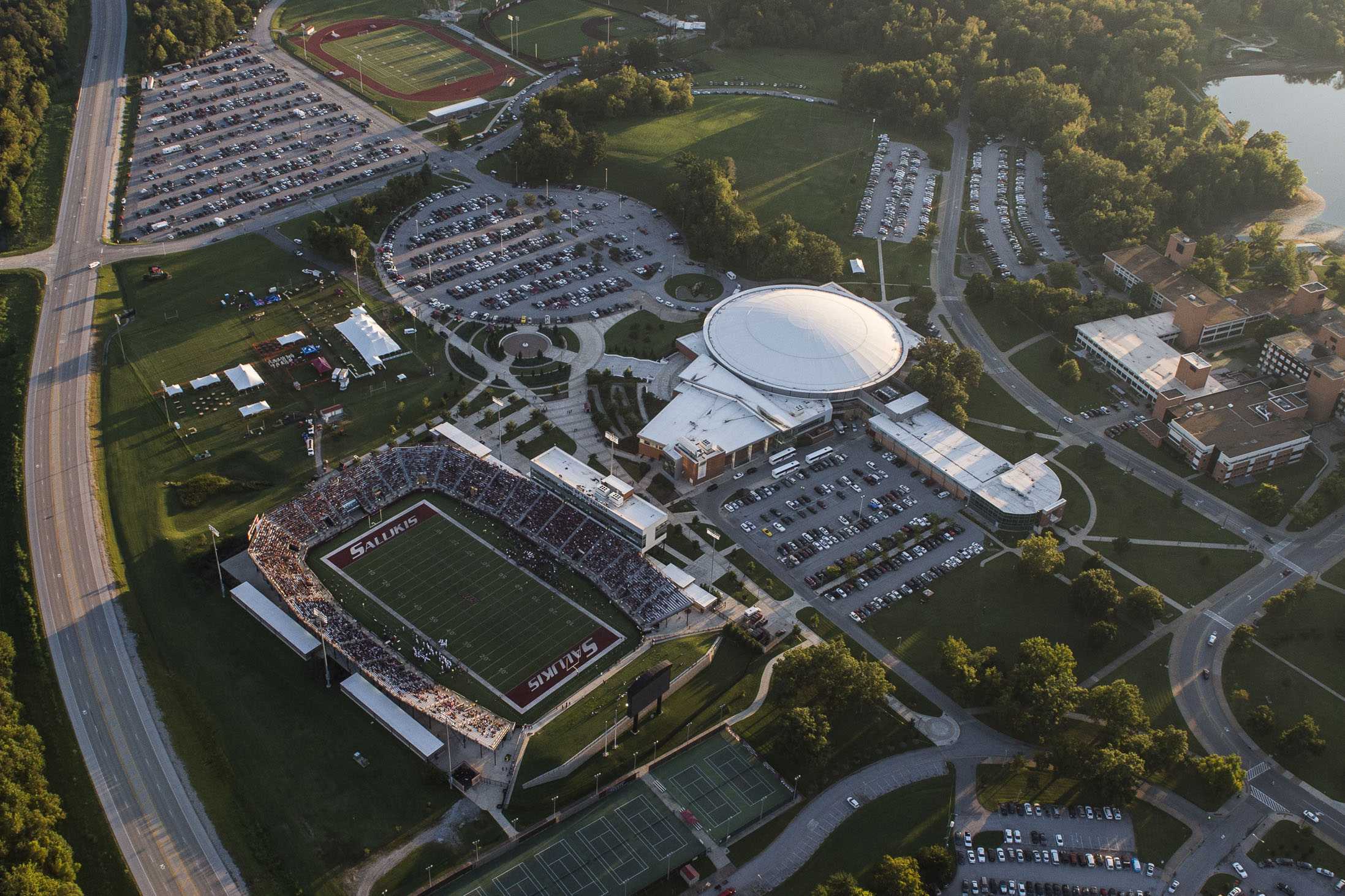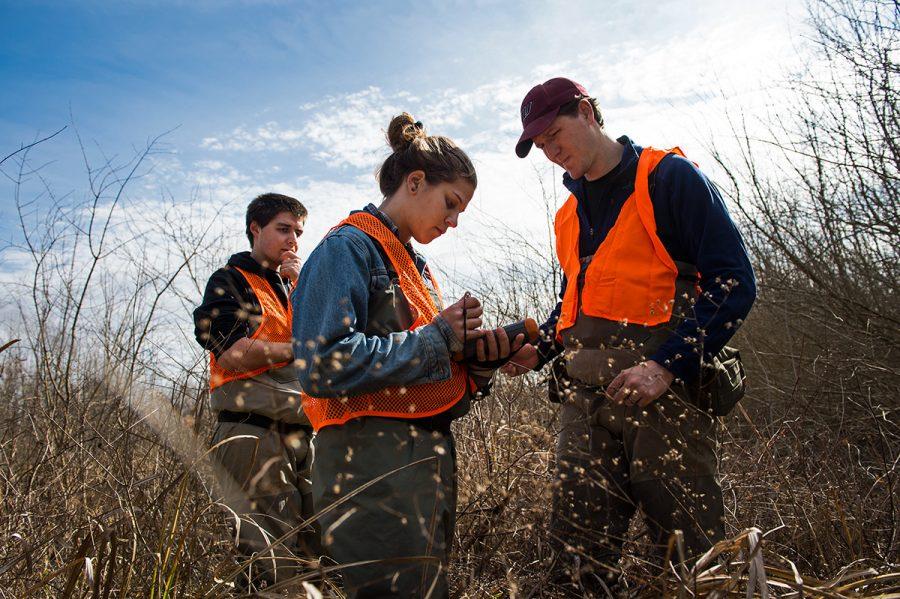SIU releases new report to prioritize potential budget cuts
Pulliam Hall can be seen Jan. 30, 2017, on the university’s Carbondale campus. (Jacob Wiegand | @jawiegandphoto)
February 23, 2017
The university on Thursday released a report to highlight feedback and prioritization of SIU’s non-academic program review and identify areas for potential budget cuts.
After prioritization of the initial report, the 15 centers or initiatives that may be slated for dramatic cuts to state funding are still at risk. Some of these initiatives include the university’s Center for Fisheries, Aquaculture and Aquatic Sciences, WSIU Public Broadcasting and Counseling and Psychological Services.
Directors of these centers have said the cuts outlined in the university’s Non-Instructional Program Review Committee’s report would significantly harm their units, and in some cases — such as SIU’s Office of Economic and Regional Development and Cooperative Wildlife Research Laboratory — would lead to their closure.
Advertisement
The committee suggested these units could become self supporting, with the goal of eliminating state funding by 2022. This is expected to save the university $5.5 million in five years.
In the newest report, the Chancellor’s Planning and Budget Advisory says it “worked assiduously” to review the recommendations outlined in the original report. The council said the findings are fluid and still being considered.
University spokeswoman Rae Goldsmith said it is “just one more piece” to inform the chancellor’s thinking on these issues.
The chancellor’s council prioritized 12 larger proposals from the first report in the order of which has the greatest financial impact to the university. Eliminating deficit spending is at the top of that list, followed by cutting state funding to the 15 centers and initiatives.
Cuts to the centers would not be the first implemented in recent years. They suffered a permanent 10 percent reduction in state funding in fiscal year 2016, according to the initial report. Others saw additional cuts in fiscal year 2017.
In late January, SIU President Randy Dunn said these centers are what make SIUC a unique campus.
“If we just start doing away with those things, I’m afraid we’ll never get them back,” Dunn said at the time.
Advertisement*

The council put exploring savings related to employment practices and identifying opportunities for shared services near the top of that list. It also prioritized the committee’s suggestions to explore outsourcing and review administrative organizational structures for cost saving opportunities.
The group — chaired by Michael Behrmann, chairman of SIU’s automotive technology department — also prioritized:
- Ensuring accountability for and compliance with existing policies and guidelines
- Generating revenue to reduce reliance on state appropriation
- Streamlining business processes and workflow
- Enhancing efficient use of technology
- Exploring efficient use of facilities
The chancellor’s advisory council also outlined six items from the report that “appear to be easier to quickly implement.” One of these is to consolidate the university’s software contracts and purchasing with those from SIU-Edwardsville and the SIU School of Medicine in Springfield.
This would help ensure the information in the contracts remains secure and prevents duplicate or redundant purchases, according to the non-academic prioritization committee’s original report. This process has already started, and SIUC and SIUE have so far saved $1 to $2 million in the past two years.
Other recommendations the council says should be pursued now include:
- Moving forward with the full implementation of HireTouch, an automated employee hiring service that would streamline some procedures. The initial report says HireTouch would reduce the amount of paperwork from department to department and improve efficiencies in data entry, sharing and approvals, among other procedural issues.
- Holding employees accountable for appropriate use and timely reconciliation of purchasing card expenses, which the university says reduces paperwork, speeds the purchasing process and returns more than $300,000 in rebates each year to SIU, according to the initial report.
- Continuing to monitor the progress of strategies that have been implemented to increase on-campus enrollment. SIUC reported a total enrollment of 14,636 students for the spring semester, more than 12,600 of whom take classes on campus.
The chancellor’s advisory council also outlined 10 recommendations it said may be more difficult to implement or may require further analysis, such as reviewing each college’s administrative and organizational structure and aiming to reduce or eliminate administrative costs.
Another suggestion is identifying an “appropriate and consistent level of support” for the university’s athletics department.
In the original report, officials say although state funding allocated to Saluki Athletics is less than 1 percent of the annual funding for the campus, that money does not cover the current operating costs of the program.
“The athletic department deficit spending is not sustainable in the long term,” the non-academic prioritization committee wrote in the original report. “Given the significant deficit, a major review of the athletic operation should be conducted with the goal of developing a clear, executable plan with measurable targets.”

In January, Saluki Athletics announced it will eliminate its men’s and women’s tennis teams July 1. During the same announcement, the department also said it will reduce the number of men’s swimming scholarships.
Other recommendations the council said could be more difficult to implement include:
- Seeking direction to reduce number of days for Extended Sick Leave benefit and non-accruable sick days.
- Changing the Extended Sick Leave benefit policy to require employees to use 10 days of his or her accrued vacation or sick leave before ESL is effective.
- Plant and Service Operations developing a cost analysis of services and benchmark.
- Evaluating units that are not self-supporting to determine a reasonable plan to reduce and ultimately eliminate state support.
- Identifying units that may be moved to different reporting lines to maximize shared services and efficiencies.
- Identifying deficit spending units and establish formal repayment plan.
- Exploring other alternative sources of revenue that serve to advance the university’s mission.
The university’s Non-Instructional Program Review Committee held its first meeting in February 2016.
Since July 2015, Republican Gov. Bruce Rauner and Democrats who control the state Legislature, including House Speaker Michael Madigan, have failed to come to an agreement on a state spending plan. Because of this, public universities are searching for ways to continue operations with the assumption some funding could be cut permanently.
Two stopgap measures passed through the Legislature in 2016 totaled $83 million in financial support for the SIU system. Those funds, for the most part, were used to pay the bills from the 2016 fiscal year, officials said.
SIU started the 2017 fiscal year “basically back at zero” and is dipping into the reserves again, Dunn has said.
Though the university is not in a position where closure is being considered, Dunn has said it would be difficult for SIU to continue functioning for another 18 months without having to “dismantle big parts of the university operation.” Should no appropriations be made by June 30, the university president said SIU would be “running on fumes.”
Staff writer Marnie Leonard contributed reporting.
Staff writer Luke Nozicka can be reached at lnozicka@dailyegyptian.com or on Twitter @lukenozicka.
To stay up to date with all your SIU news, follow the Daily Egyptian on Facebook and Twitter.
Advertisement











Max Yen • Feb 24, 2017 at 12:11 pm
Among the higher education institutions, there are institutions getting bigger and richer and there are universities getting smaller and poorer. SIU can be classified in the latter case. Illinois State budget short fall make it worse. Regardless how SIU’s budget cut ended up, here is what I see: (1) you are going to lose you ability to make extra revenues through the creativity of Saluki people, (2) you are adding extra load (by cutting positions) so that everyone are trying to keep their job leaving not create new jobs, (3) aging facilities, building, and technology will not be replaced and or refurbished for an extended time, (4) university ranking will keep falling, (5) SI communities will not have prudent business so goes the economic development and entrepreneurship…
So, SIUC as the “former” economic engine will have to find a creative way to handle its financial crisis. Cutting can not be at the expense of the goose who lays golden eggs – continue invest to your future is still needed. Any new initiatives that can attract new revenues (independent of the State) will have to happen in a disrupted way, you have the talents to do it! Realign yourself for what’s needed in the society for jobs for students-use that to sell to the parents of the potential students. Re-alignment is not an attempt to kill someone’s job but to find the best use of one’s talent in a multi-disciplinary world. Should there be STEM in arts and liberal arts. Shouldn’t your professional school graduates be equipped with humanity and philosophical mindset.
The bottom line is don’t just treat the budget cut as the end game but treat it as an intermediate step and include you vision of future new SIUC as part of your equation. This is the shrinking for the cause of sustainability and growth. I have no doubt that SIU will continue to exist. At what form and stature, you decide!